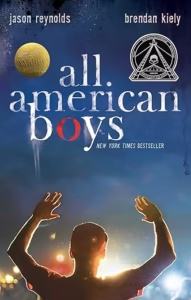All American Boys
Jason Reynolds and Brendan Kiely
Simon & Schuster
Published September 29, 2015
Amazon | Bookshop | Goodreads
About All American Boys
Rashad is absent again today.
That’s the sidewalk graffiti that started it all…
Well, no, actually, a lady tripping over Rashad at the store, making him drop a bag of chips, was what started it all. Because it didn’t matter what Rashad said next—that it was an accident, that he wasn’t stealing—the cop just kept pounding him. Over and over, pummeling him into the pavement. So then Rashad, an ROTC kid with mad art skills, was absent again…and again…stuck in a hospital room. Why? Because it looked like he was stealing. And he was a black kid in baggy clothes. So he must have been stealing.
And that’s how it started.
And that’s what Quinn, a white kid, saw. He saw his best friend’s older brother beating the daylights out of a classmate. At first Quinn doesn’t tell a soul…He’s not even sure he understands it. And does it matter? The whole thing was caught on camera, anyway. But when the school—and nation—start to divide on what happens, blame spreads like wildfire fed by ugly words like “racism” and “police brutality.” Quinn realizes he’s got to understand it, because, bystander or not, he’s a part of history. He just has to figure out what side of history that will be.
Rashad and Quinn—one black, one white, both American—face the unspeakable truth that racism and prejudice didn’t die after the civil rights movement. There’s a future at stake, a future where no one else will have to be absent because of police brutality. They just have to risk everything to change the world.
Cuz that’s how it can end.
My Review
This book has been on my reading list for years. I’ve heard so much about it, from the awards that it garnered to the way the story moves readers. In some ways, I feel like I don’t have anything to add to the conversation that hasn’t already been said. It’s an incredible book.
I love that the authors chose to tell this book from two different perspectives: a black boy who experienced brutality at the hands of a police officer and a white boy who bore witness.
Through Rashad’s perspective, we are asked to walk through the physical pain, the shame, and the rage that he feels as a result of his experience. We see his family’s different reactions. His friends.
Then we step into Quinn’s point of view, and we walk through his discomfort. We watch him wrestle with how to respond and what actions to take. We have to sit with the discomfort that he feels. Like Quinn, we go beyond sympathizing with the boy in the hospital. His perspective asks us to do that emotional work for ourselves.
Having point of view characters of two different races also crafts the conversation about race within the story in terms of how racism and privilege impact us all. This is the kind of book that makes you think, and it’s couched in such an accessible story. Both points of view are written conversationally, so it feels like a friend relating what happened directly to you.
I read this book in a single day. It’s the kind of book that you don’t want to put down. Even though I’ve finished, I find myself returning to some moments in the story to think about them again. There’s a lot to think about in these pages.
If you haven’t read All American Boys, add it to your reading list. It’s the kind of book that asks you to listen and bear witness in a really necessary way. Especially now.
Content Notes
Recommended for Ages 14 up.
Profanity/Crude Language Content
Strong profanity appears in the book.
Romance/Sexual Content
References to some romantic attraction.
Spiritual Content
References to church service and prayer. Rashad shares his anger at the idea that God watched what happened to him and allowed it to happen. He wonders if he’d feel better if God was looking away or busy instead. He shares these feelings as he’s processing what happened to him and the things that other people say to him about it.
Violent Content
References to police brutality. One scene shows a police officer beating up a teenage boy from the boy’s perspective. Other scenes reference this moment from other perspectives.
Another officer shares an experience in which an unarmed teen was shot.
Police wait at the site of a permitted protest with a tank as if they expect rioting and violence.
Drug Content
Teens drink alcohol from a flask. One boy convinces a man to buy beer for him and his friends, who are on their way to a party.
Note: This post contains affiliate links, which do not cost you anything to use but help support this blog. All opinions are my own.
